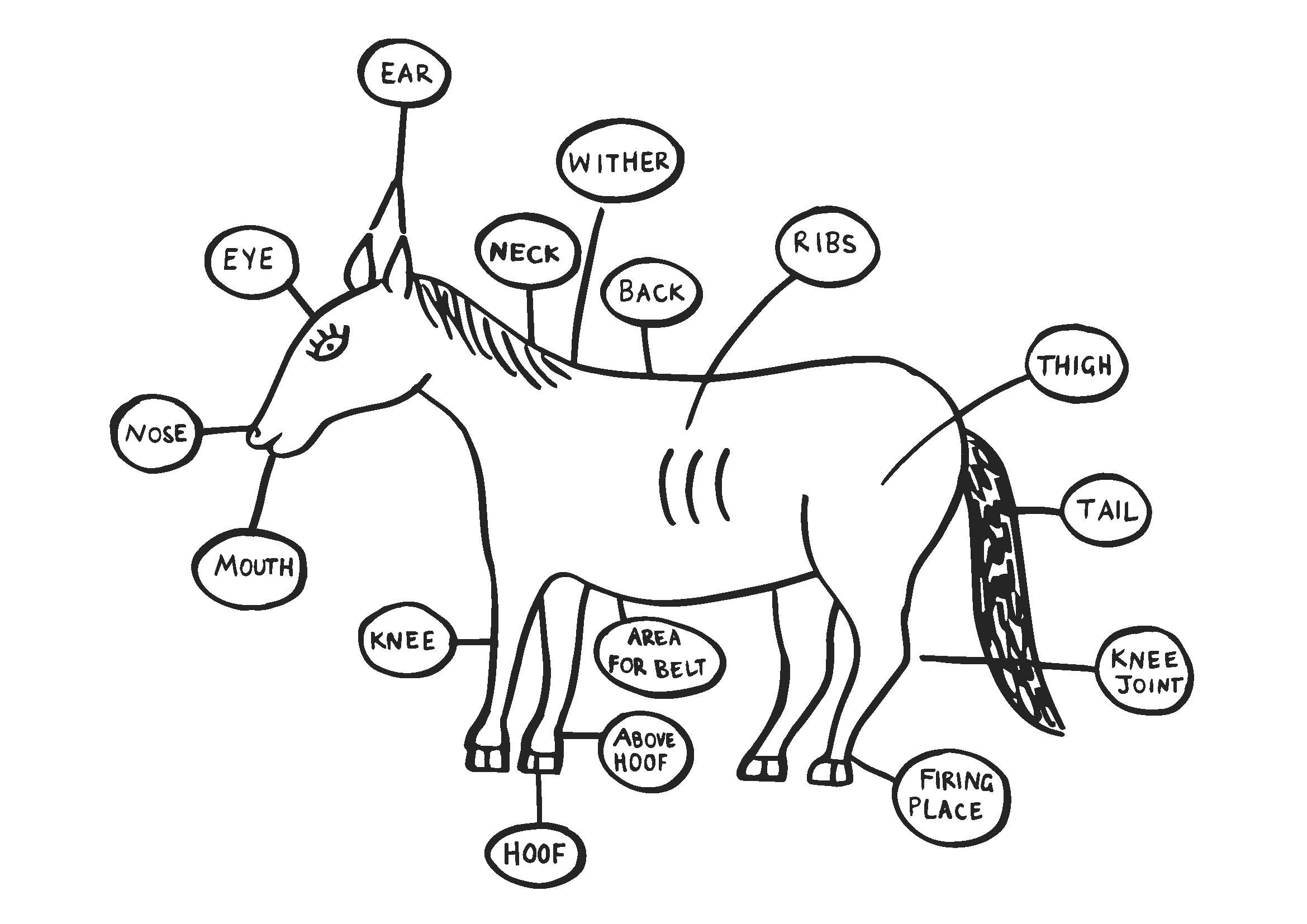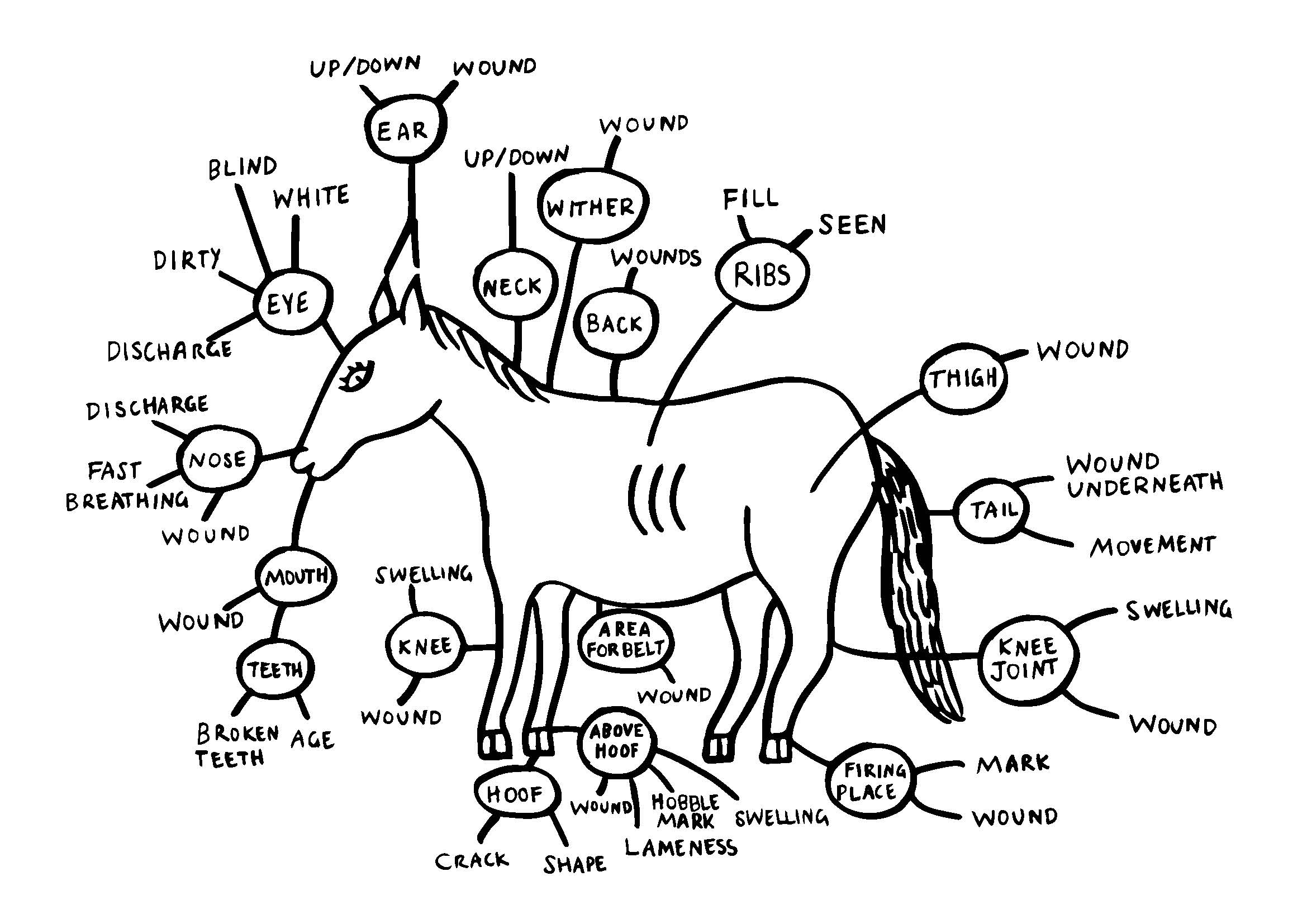QUICK LINKS
T20 Animal Body Mapping
T20a Animal Body Parts Map
T20b Animal Body Issues Map
T20c Animal-based welfare indicators Map
T20: Animal Body Mapping
Animal body parts map, animal body issues map and animal-based welfare indicators map
A body map is a picture an animal showing the parts of its body, their functions, and the body areas affected by wounds or diseases. The map depicts either the whole body, or part of the body, as it is perceived by individuals or a community group. This tool can be used to map animal body parts and wounds or disease symptoms on the body, which can be useful in the concept of a project to gain an understanding of how people understand their animals’ bodies, and their perception of common welfare issues on animals’ bodies. It can also be used in the planning phase to map animal-based indictors of good and bad welfare status, which can help inform indicators used in participatory welfare assessments.
| Tool purpose: | Time needed: |
| Body part mapping • To identify local names for parts of an animal’s body. • To uncover and discuss traditional beliefs about animal body parts. • To explore the different perceptions that people have about their animals’ body parts and their associated roles and functions. • To act as an educational tool that introduces participants to the roles and importance of different body parts. Animal body issues map • To identify problems on animals’ bodies which they perceive as issues and their believed causes. Animal-based welfare indicators map • To understand what people perceive to be good and bad indicators of welfare. | 2 - 3 hours |
| Materials needed: | |
| Sticks, coloured powder, chart paper, markers. Broken horse or donkey puzzle if available. |
Keyword Search Tags
Project Phase:
Initiation Phase, Planning Phase
Approaches for Working With Communities:
Community Development Approach, Community Engagement Approach
Behavioural Drivers (COM-B):
Capability
Project Support:
Participatory Learning and Action Tools
Specific Topics:
Animal Welfare, Feelings and Needs
T20a: Animal Body Parts Map
This basic animal body parts map allows participants to identify their animals’ body parts, providing an indication of how participants perceive their animals’ bodies.

Figure T20a Simple animal body parts map of a working horse
Ten members of working animal owning households produced the simple animal body map above. The animal owners named all known parts of the animal and provided the local names for each part.
T20b: Animal Body Issues Map
The animal body issues map is a natural follow-up activity to the body part and is useful for understanding what participants perceive as normal versus unhealthy. For example, in places where animals have similar welfare problems, such as being thin, owners often perceive thinness to be normal and do not identify it as a problem. In the example below, participants were encouraged to describe the issues - or problems - that affect each body part. The group drew the identified issues on the animal body map (T20b). They indicated their believed causes (when known) and added them to the map next to the associated issue.

Figure T20b Animal body issue map, indicating body issues and causes on a working horse
Through this exercise, the group identified the following wounds:
- Nose due to nostrils being slit
- Mouth due to where the bit rests
- Eyes due to uncleanliness and dirt
- Ears due to cutting
- Back due to saddle wounds
- Barrel due to friction from cart rope
- Pastern/fetlock (above hoof) due to hobbling
- Knee due to fall
- Dock (tail area) due to cart ties
- Rump from use of whip
T20c: Animal-based welfare indicators Map
The animal-based welfare indicators map is a useful follow up activity to the animal body parts map. This activity identifies what the animal-owning households perceive to be good and bad indicators of welfare on an animal’s body.

Figure T20C Animal body indicators map of a working horse
Figure T20C is an example of an animal-based welfare indicator map that was created by members of a working animal-owning community. Participants identified characteristics of what they believed a normal, healthy working animal should look like and wrote the identified healthy indicators next to the associated body parts identified in the first animal body mapping activity. They were then asked to identify unhealthy indicators of the same characteristics, and included those on the map. When participants initially completed the map, they only identified a few indicators associated with poor welfare. At this early phase of community engagement, participants had not yet been introduced to concepts of animal welfare, and the activity identified gaps in their knowledge; for example, they incorrectly identified the presence of frog in their working donkeys’ hoof as a poor indicator of health.
This exercise can be repeated and Figure 20c updated and revised to correct any inaccurate indicators after participants’ complete their first participatory animal welfare needs assessment (PWNA) (see recommended next steps T22 Animal Welfare Transect Walk), where they will learn how to identify good and bad animal welfare states related indicators. Once updated and accurate, this animal body map of welfare issues and indicators can then be used to inform action planning.
| Animal Body Parts | |
|---|---|
| Step 1 | If the animal parts puzzle is available use this and ask participants to put it together, or alternatively ask them to sketch the body of their animal on the ground or on paper, and to identify the different body parts and the local names used for each body part. |
| Step 2 | Once participants have identified all body parts, initiate a discussion on their perceptions of the role and function of each part. This discussion often creates an opportunity for facilitators to sensitize participants about which body parts are important to animals’ function, which is particularly relevant in relation to working animals. |
| Animal body issue map | |
| Step 3 | Follow step one above, then ask the group to identify issues they commonly perceive on the body of their animals. This may include wounds, symptoms of disease, or other problems with animal health or function which they observe. It is important to allow participants to identify what they perceive to be issues, rather than identify issues you as the facilitator perceive. Encourage participants to draw these issues on the body map or represent those using symbols next to the appropriate body part. |
| Animal-based welfare indicators map | |
| Step 4 | Using the animal body parts map (steps 1 and 2), ask participants how a normal, healthy animal should look. Starting the discussion with the question ‘What parts of the body do you look at when purchasing/adopting an animal?’ can be useful. Through this question, participants will typically start to identify what they perceive as indicators of good animal health or welfare as observed on an animal’s body. Ask them to write or draw symbols representing the indicator next to the associated body part on the map. As a follow up question, ask participants what poor animal health or welfare would look like, or what they consider to be an indication of poor health or condition when purchasing an animal. Through the discussion, differences in ideas about indicators will emerge and they will sensitize one another to reach agreement. At this stage, it is common for only a few indicators to be identified, especially related to poor animal welfare conditions. Some identified animal-based indicators may be incorrect, highlighting gaps in knowledge, perception about the animal body part and misguided beliefs of welfare. This is gives rise to opportunities for future sensitization on good and bad welfare states. |
| Step 5 | The animal-based welfare indicators mapping activity may be revisited after conducting an initial participatory animal welfare needs assessment (PWNA) in the initiation/planning phase of the community project cycle (T22 Animal Transect Walk). Through the PWNA exercise, participants gain greater understanding of good and bad welfare states and associated animal-based indicators, which they can use to update, add to, and/or correct the indicators on their initial animal-based welfare indicators map (see figure T20c above). At this time, the facilitator may ask probing questions about different body parts related to what was observed and learned through the transect walk in terms of indicators of problems and good welfare states. Encourage participants to create a comprehensive body map of animal-based parameters for assessing animal welfare relevant to their local context. These can then later be used to inform indicator selection for future transect walks to support monitor community-based action plans/for individual personal action plan and monitoring. |
Facilitator's Notes
- This tool has been adapted into a ‘Broken Horse’ jigsaw puzzle, where animal body parts are discussed by reconstructing a wooden jigsaw of an animal. This puzzle version of the exercise is good for starting discussions about animal welfare with children.
Next Steps
- Issues and related causes identified through this exercise can provide a preliminary indication of perceived animal welfare issues during the initiation phase. Deeper analysis of root causes can be explored during the community action planning using T25 Problem animal and/or T26 Cause and effect analysis.
- Consider following up with T22 Animal welfare transect walk to:
- Ground truth animal welfare issues identified by participants during the mapping exercise, with animals’ actual observed body condition, which can highlight potential gaps in participants’ understanding of welfare issues.
- Sensitize participants on good and bad welfare states and associated animal-based indicators.
- Identify the most commonly observed animal welfare issues including animal-based indicators, resource related issues and environmental issues.